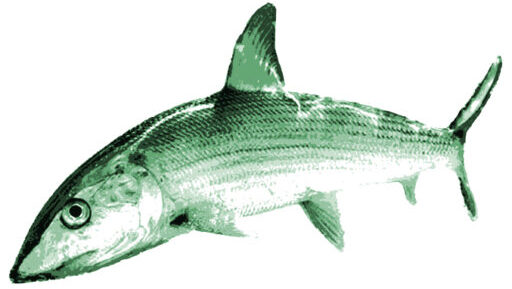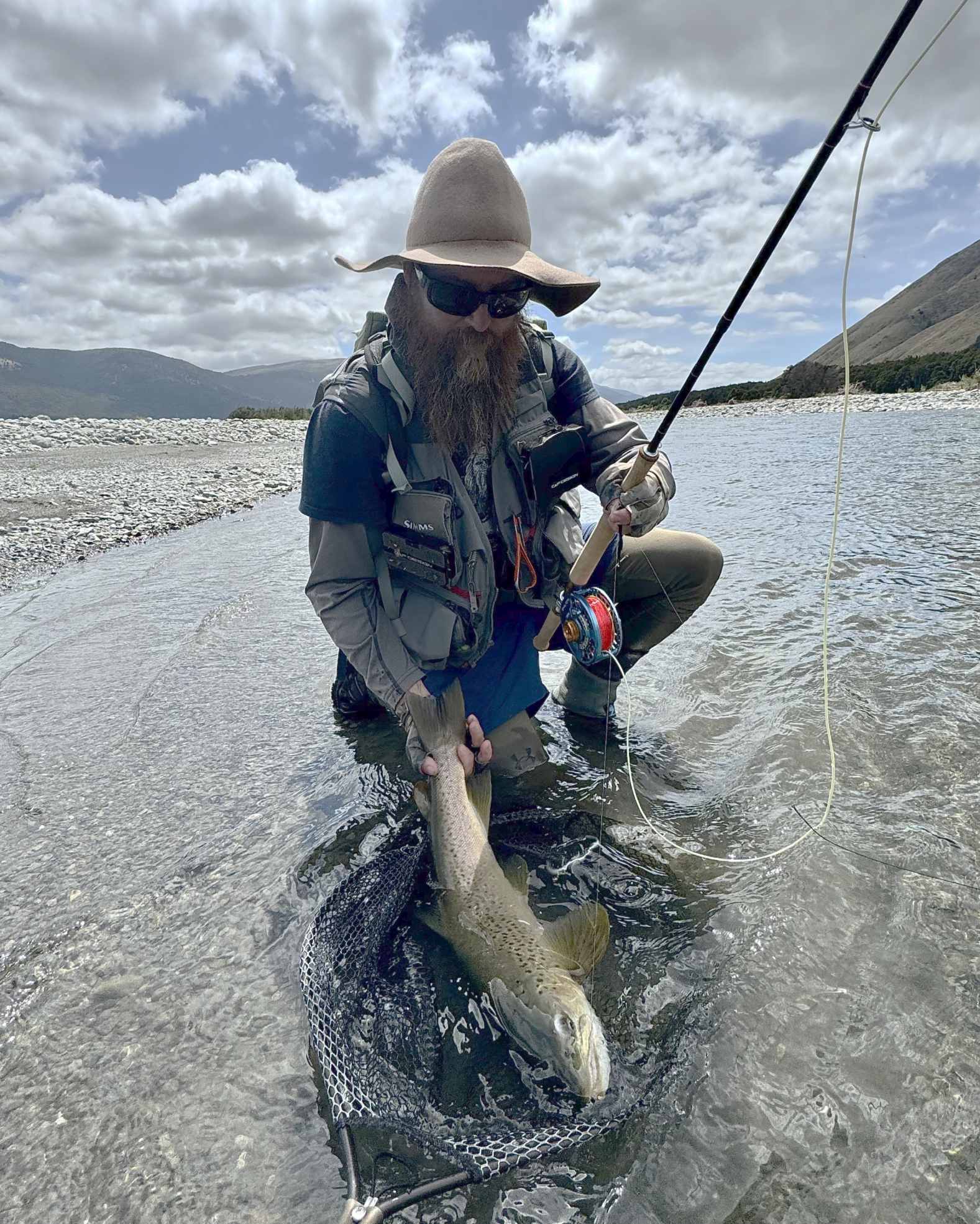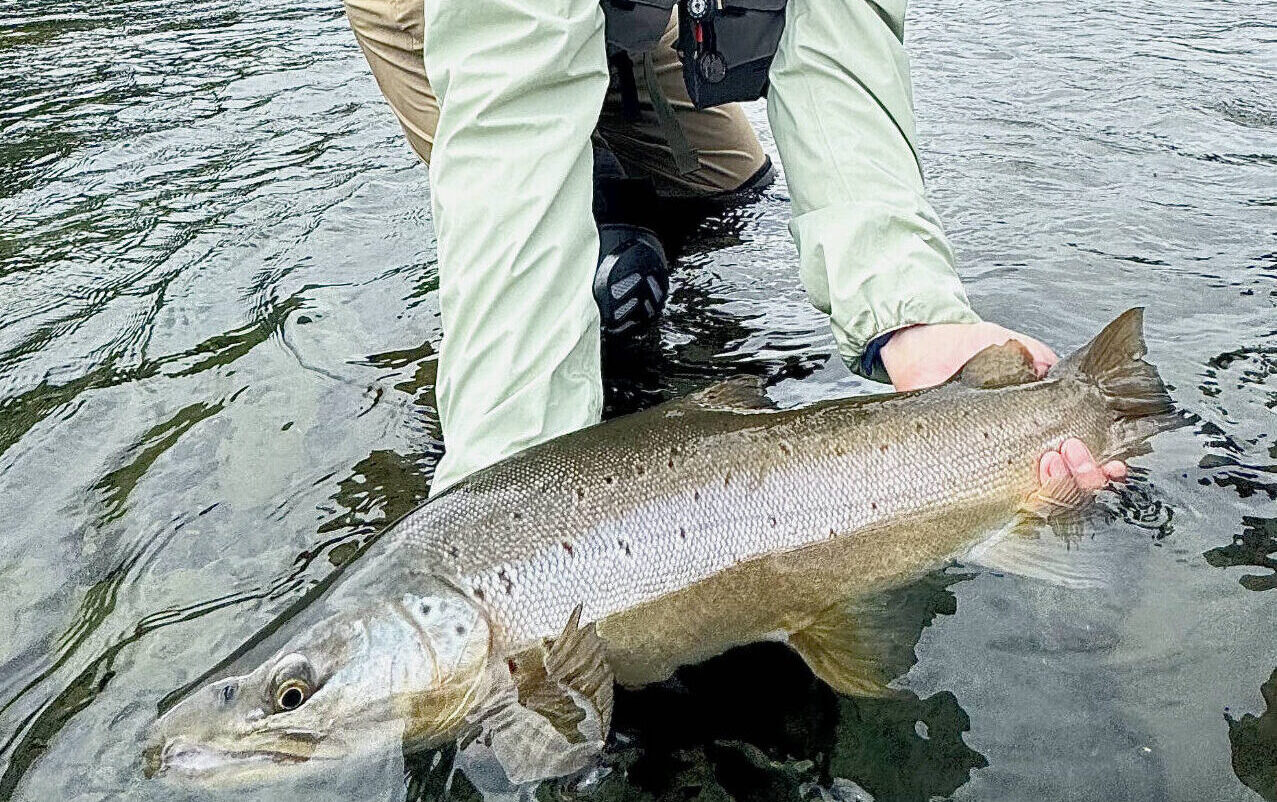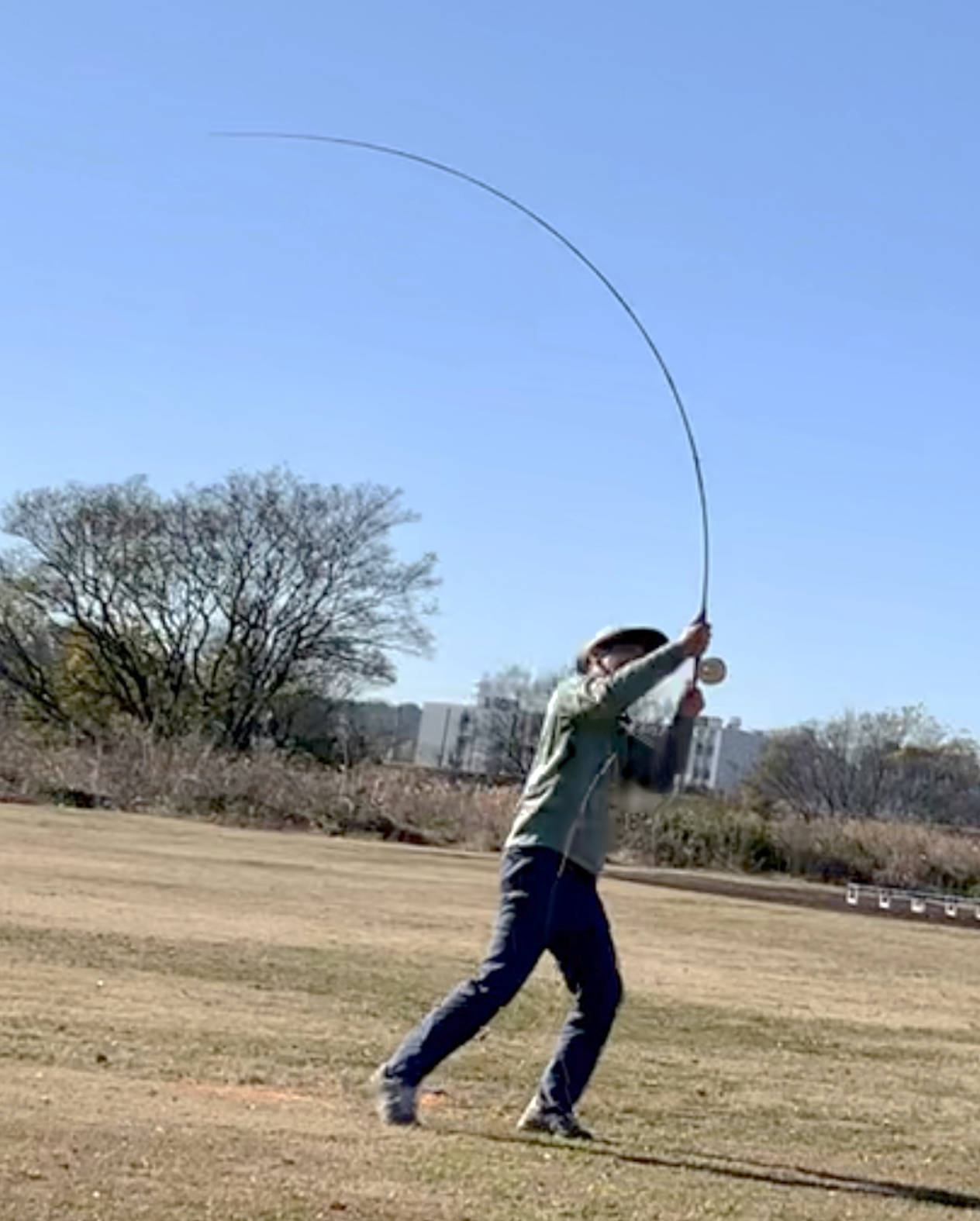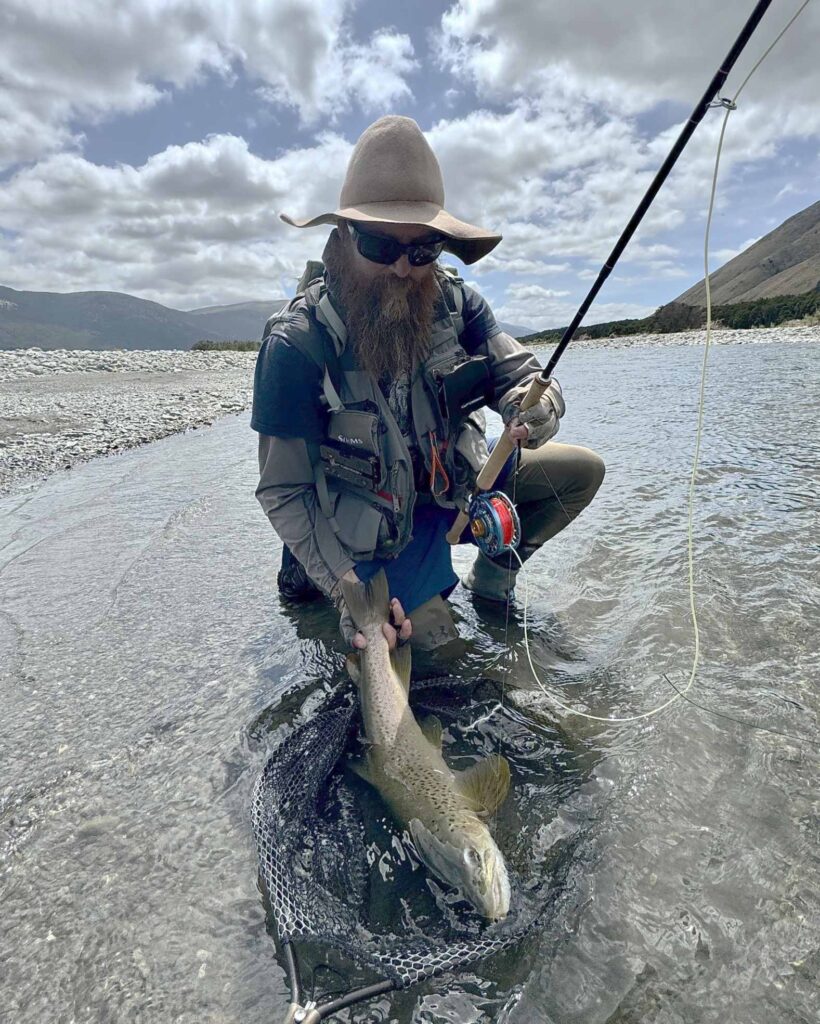
我々のガイドのBlair。ハードワーカー、ワールドクラスの超優秀ガイドだった。それに彼自身が筋金入りのフライフィッシングオタク。 Our guide, Blair, was a world-class, exceptionally hardworking guide. On top of that, he was a complete fly-fishing fanatic.
2-16-2025 Scroll down for English
今回のNZの旅で、私は翔平と以下の達成ゴールを見据えていた。
- 背中がグリーン、頬っぺたが青銀色の通称 ”グリーンバック・ブラウン” のトロフィーフィッシュを釣ること。
- シートラウト(降海性ブラウン)を釣る可能性を見極めること。
- NZでは殆ど普及していないスペイフィッシングがいかに成立するのかを確かめること。
前回、Part 1では、1)の ”背中がグリーン、頬っぺたが青銀色の通称 ”グリーンバック・ブラウン” と 2) ”シートラウト(降海性ブラウン) “ を紹介したので、今回は、3)のNZでスペイフィッシングがいかに成立するのか?を紹介したい。
今回、我々は大きめの川に入る時には、11ftのツーハンドスペイロッドも持ち込んでいて、翔平と良さそうな瀬に来るとドライで叩いた後に、スペイギアでウェットフライとストリーマーをスイングしてみたのだった。
3日目にいかにも魚が着きそうな大きなトロ瀬に差し掛かった時に、散々ドライとニンフを流しこんだにも拘らず反応がなく、お腹も減ったのでランチブレークを取ることにした。食べ終わってから、さあ、次はスペイでスイングの番だ!キャストを始めるも反応は、やっぱりなし。
ガイドのBlair (ブレア) が、「Hiro,スペイキャスティングのワンポイント・アドバイスをくれない?」と言って来たので、「よし、やろう!」ということになった。彼は、カナダのスキーナに自分の車とボートを年間を通して常駐させているほどのスチールヘッド・フリーク。そんな彼だからショート・スカンジラインをペリーポークで投げるのはお手のもので、スカジットキャストとして投げるなら、綺麗にキャストしていた。
Hiro:「うん、悪くない!特に言うところはないけど、もし長めのラインのスカンジラインとして投げるなら、スイープは腕中心に後ろに運ぶんじゃなくてボディーターンで持って行くこと、それとスイープの終わりでトップハンドとボトムハンドを結んだ線が胸板と平行になるようにすればもっとロッドにラインウェイトが乗るんじゃないかな。そのために練習ドリルはペリーポークより、シングルスペイがこの動きをブラッシュアップするにはいいと思うよ。」とアドバイスした。
で、翔平の持って来た11ftのスペイロッドを私は手にした。3回目のキャストをシングルスペイでダウン&アクロスに投げてフライの着水を見届けると、そのままスイングさせてフライが水中にある状態のまま 「はい、今度はBlairの番、どうぞ!」 とロッドをBlairにバトンした。するとその2秒後、なんとそのスイングで型のいいカッコいいブラウンがヒットしてしまったのだ! 我々が散々釣り込んで場荒れした後のスポットで、それもスペイギアで世界で最も怖がりのブラウンを釣るとは誰も思ってもいず、ランディングすると全員が大声で笑った。何とも幸せな気分だった。
ニュージーランドのブラウンは私のフライフィッシングの経験に照らすと、その警戒心の度合いはフロリダやハワイのボーンフィッシュほどまでではないにしても、トラウトとしては世界の中でも一級に高い。サイトフィッシングで見えている魚にフライを打てる回数は、相手を警戒させてしまうのでひじょうに限られる。フライにドラグが掛かったら最後、それを見ている魚は瞬時にどこかに消えてしまう。 その時にスペイ(スイング)フィッシングは、意図的に “ドラグ(スイング)” を掛ける釣りなので、ある意味で、南島のブラウンから見れば全くの不審物としか目に入って来てこない、と言う可能性は念頭においておくべきだ。
NZのブラウンは、流心脇の淀み、トロ瀬の真ん中と言ったいかにもレインボーやヤマメが好みそうな場所には殆どいなくて、川幅30mの川であっても岸寄り2、3メートルの岩のストラクチャーがあって流水がひじょうに緩やか場所に見える場合が90%。この手のスポットは、スイングには余り向かない。私が投げてBlairに手渡したフライは、まだ攻めていなかった対岸ギリギリにダウン&アクロスでプレゼンテーションされて、たまたまストラクチャーに上手くフライが入っていき、ストリーマーの動きがブラウンにスイッチを入れたのだろう。今回の旅で翔平は頑なにスペイにも拘っていたのだけど、フライがブラウンのフィーディングラインに入っても、ブラウンがフライの50cm近くまで近寄った時点でフライを擬物と見切って、脱兎の勢いでどこかに去って行く場合がひじょうに多かった。
結論。今回のNZ南島での私の印象は、下流から河口近くの汽水域で小魚を捕食しているブラウン、シートラウトを狙う以外は余りツーハンドのスペイロッドを持って行く価値はなくて、むしろ大きめの川では9.6フィートのロッド一本でドライ/ニンフフィッシングととシングルハンドスペイを兼ねるのが正解、と思った。但し、NZ北島でレインボーを狙うならツーハンドのスペイロッドが発言する機会は十分あるであろう。因みに9から9.6フィートのロッド一本で、一日を過ごすなら、シングルハンドスペイに切り替えたい時に、トラウトスペイのラインに替えるのは面倒くさいので、ウェイトフォワード・ラインの先端に10フィートのミディアムシンクレートのポリ・シンキングリーダーを付け足すだけで十分だ。 (↓に続く)
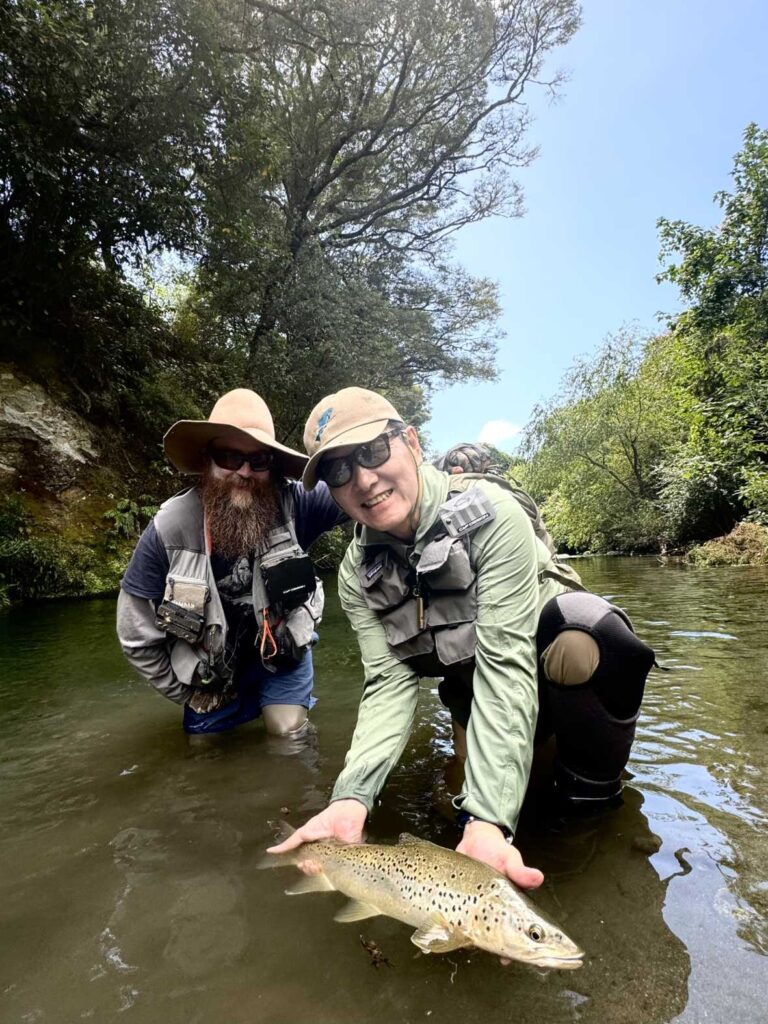
For this trip to New Zealand, Shohei and I had set the following goals:
- Catch a trophy “Greenback Brown”—a brown trout with a green back and blue-silver cheeks.
2. Assess the potential for catching sea-run brown trout (sea trout).
3. Test how Spey fishing—still relatively uncommon in New Zealand—could work on rivers.
In the previous NZ trip diary Part 1, I introduced the “1.Greenback Brown” and the “2.sea-run brown trout.” This time, I’ d like to share my impression of how well Spey fishing can work in South Island NZ.
For this trip, we brought 11ft two-hand Spey rods whenever we fished in larger rivers. When we came across promising riffles, we first fished with dry flies or nymphs, then swung wet flies and streamers using the two hand Spey rod.
On the third day, we reached at a large riffle that seemed like a prime spot. Despite thoroughly covering it with dry flies and nymphs, we got no response. We felt hungry, so we decided to take a lunch break. After eating, it was time to swing flies with Spey rod! We started casting, but there was still no bite. Our guide, Blair, said to me, “Hiro, can you give me an one point advice on Spey casting?” So I replied, “Sure, let’s do it!”
Blair is a steelhead fanatic who keeps his car and boat stationed year-round in the Skeena River system in Canada. Given his experience, he could cast a short Scandi line with a Perry Poke with ease, and his Skagit casts were already quite clean.
Hiro: ” Not bad! There’s nothing much to point out, but if you’re casting with a longer Scandi line, instead of moving the sweep backward with your arms, you should use a body turn to carry it. Also, at the end of the sweep, make sure the line between the top hand and bottom hand is parallel to your chest—this will help load more line weight onto the rod. For a practice drill, Single Spey is better than the Perry Poke to brush up this move.”
I then picked up Shohei’s 11ft Spey rod and made a few Single Spey casts. After making the third cast with a Single Spey down and across, I watched the fly land on the water and let it swing. With the fly still in the water, I passed the rod to Blair, saying, ‘Now it’s your turn, Blair. Go ahead!” Just two seconds later—bam! A beautiful, nicely proportioned brown trout hit the fly mid-swing!
After hammering the spot with dry flies and nymphs, none of us expected to catch anything, especially not a super spooky New Zealand brown trout, using Spey gear. The entire group burst into laughter as we successfully landed the fish. It was a truly joyous moment.
In my fly fishing experience, New Zealand’s brown trout are among the most cautious trout in the world—though not quite as spooky as Florida Keys or Hawaiian bonefish. Sight fishing is extremely limited, as casting too many times at a visible fish will instantly spook it. If the fly is dragged unnaturally even for a moment, the trout will disappear in an instant. In this circumstance, since Spey (swing) fishing is a technique where you intentionally apply ‘drag (swing)’, it is important to keep in mind that, from the perspective of a South Island brown trout, it might only appear as a completely suspicious object.
On this trip, we found that New Zealand’s brown trout were rarely in the main current or middle of deep runs—spots that rainbow trout or yamame (cherry salmon) would typically favor. Even in a 100 feet wide river, 90% of the time, they were positioned just 7 to 10 feet off the bank, near rocky structures in very slow-moving water. These kinds of spots are not ideal for swinging flies using Spey gears.
The fly I cast and handed to Blair happened to land perfectly on the far bank—an area we hadn’t yet fished. It swung into a structure just right, and the streamer’s movement triggered the brown trout’s predatory instinct. Shohei had been adamant about sticking with Spey gear on this trip, but even when his fly entered the trout’s feeding lane, the fish often approached within 20 inches, observed the fly for a second, and then bolted away, rejecting it completely.
Conclusion: My impression from this trip to the South Island of NZ is that unless you are targeting brown or sea trout feeding on small bait fish in the lower reaches or brackish estuary areas, there is little value in bringing a two-hand Spey rod. Instead, a 9.6ft rod would be the best choice for large rivers, allowing for both dry/nymph fishing and single-hand Spey fishing. However, if targeting rainbow trout in the North Island NZ, a two-hand Spey rod could definitely have more opportunities to shine.
Just so you know, if you plan to spend a day fishing with a single 9 to 9.6-foot rod, switching to a Trout Spey line when you want to use a single-hand Spey setup can be cumbersome. Instead, simply adding a 10-foot medium sink rate poly sinking leader to the front of your weight forward line will allow you to adapt quickly and effectively. (End)
Appendix
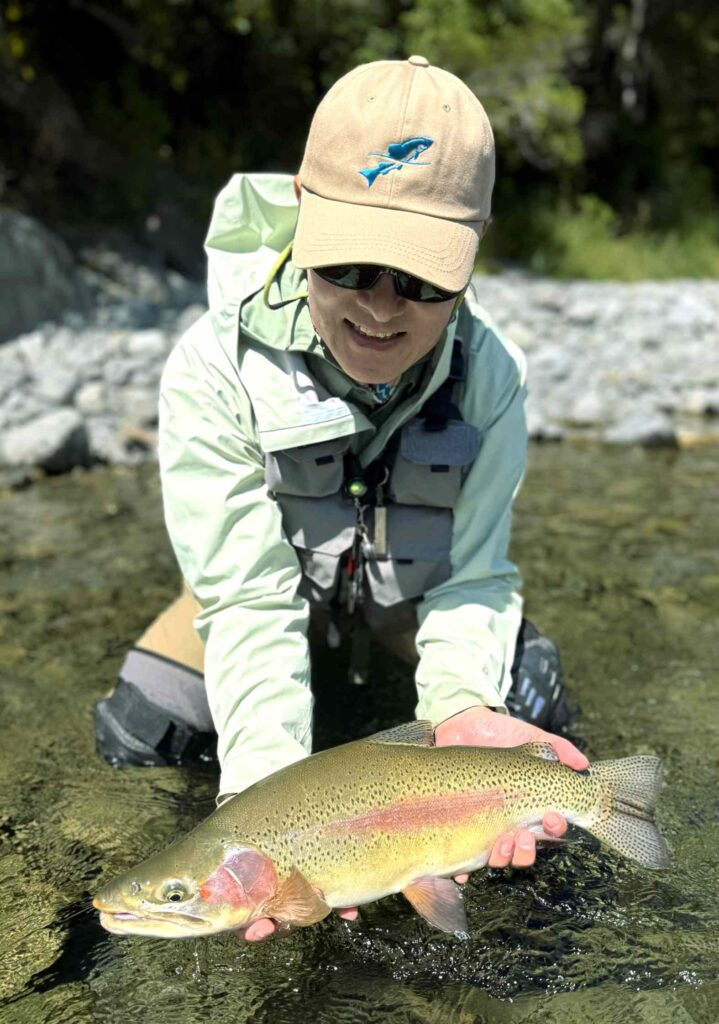
ガイドが30年間一度もレインボーに出会ったことがないと言う川でレインボーの原種に遭遇した。宝石のような一尾だった。 I encountered a native rainbow trout in a river where my guide hadn’t seen a rainbow for 30 years. It was a jewel-like stunning fish.


翔平は特注の村田バンブーロッド 7’10” 4/5番にこだわり抜き、そして最後にとうとう9ポンド80cmのブラウンまで獲ってしまった。Shohei was deeply committed to his custom-made Murata Bamboo Rod 7’10” 4/5 wt rod, and in the end, he finally landed a 9-pound, 31 inches brown trout.
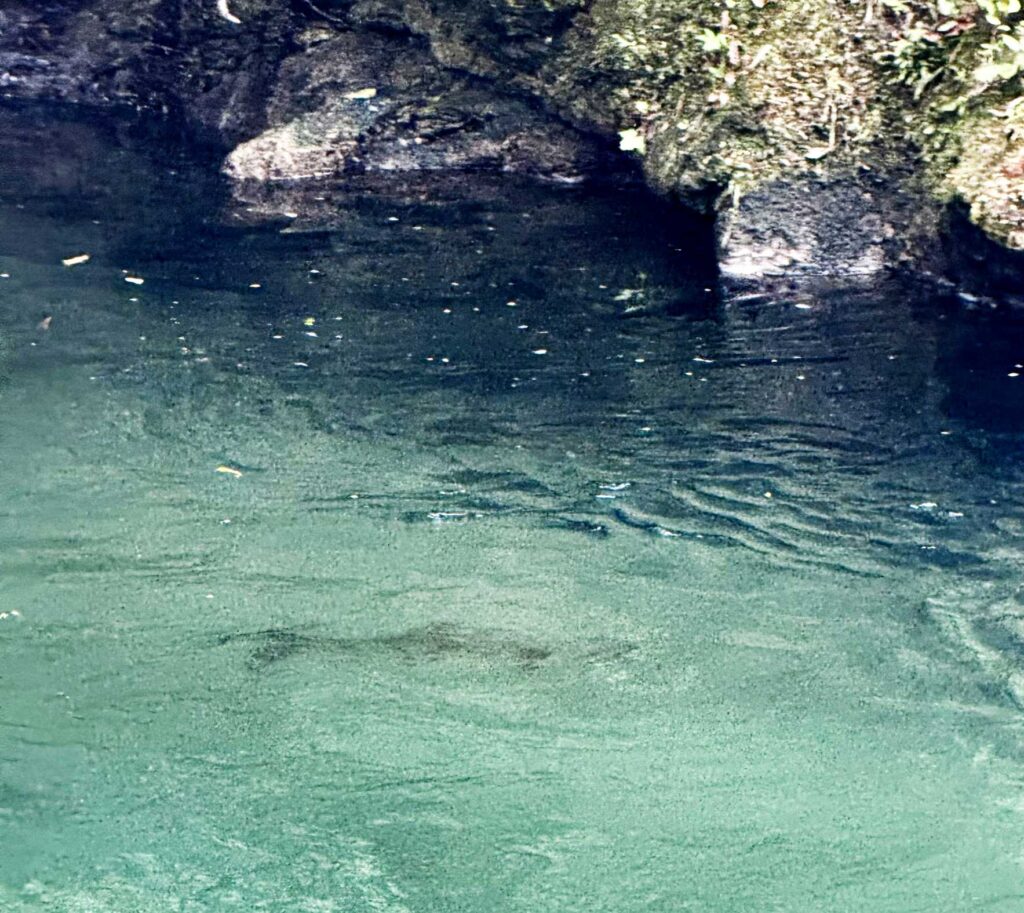
美しい淵にいたトロフィートラウト (8ポンド位?)! バッチリ食わせたのだったけど、、、、。 Trophy Brown Trout (maybe 8 pounder) in a beautiful pool. He took my fly once but ,,,,,
